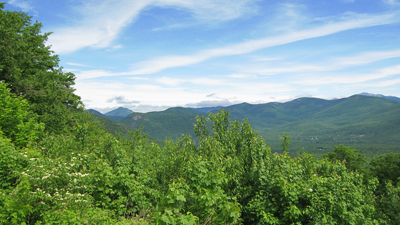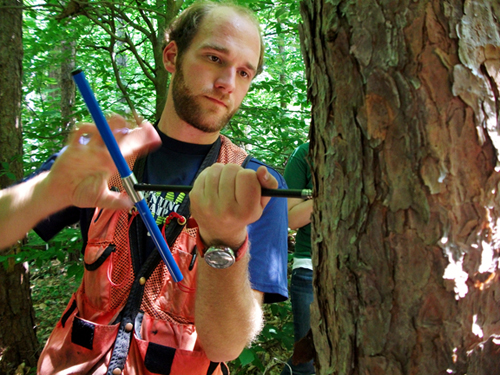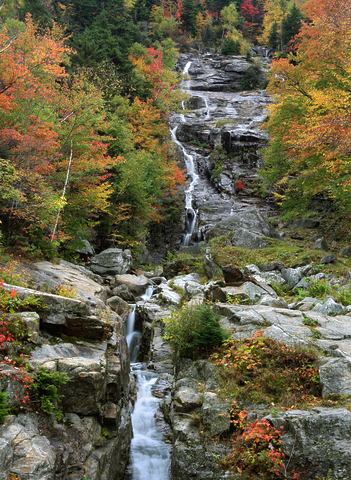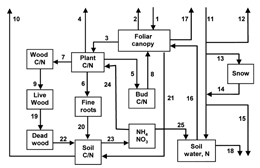Spring 2013
Climate Change Research at EOS
BACK IN 2008, when forest ecologist Scott Ollinger happened to pore over six years worth of data he and colleagues had collected on forest sites across North America, he had the rare eureka moment.
The data, derived from a novel combination of NASA satellites and aircraft, flux towers, and leaf-level measurements, had been gathered to probe various chemical properties of forest canopies. But when analyzed collectively, they revealed something completely unexpected and potentially crucial for piecing together the big picture of how forests can influence climate: forests with high levels of leaf nitrogen have a two-fold effect on climate by simultaneously reflecting more solar radiation (having a high albedo) and absorbing more carbon dioxide than their low-nitrogen counterparts.
 |
|
| White Mountain National Forest. Photo by Michelle Day, UNH-EOS. |
“Bits and pieces of evidence for this had been around for years but nobody put them together before because it was not a question we had even thought to ask,” says Ollinger, a professor in the ESRC and department of natural resources and the environment.
The newly discovered link between foliar nitrogen and canopy albedo added an interesting twist to understanding the climate system and raised intriguing questions about the underlying nature of ecosystem-climate interactions.
And the finding lends itself perfectly to the scientific goal of the Ecosystems and Society project—quantifying the current state of ecosystem services in New Hampshire—because it helps continue to pave the way for larger-scale research to be downsized to the regional and state level, and flips a critical line of scientific questioning on its head.
"Fifteen years ago, where climate change was concerned, most of us were thinking just about how changing climate would affect ecosystems, not how ecosystems would affect climate change," Ollinger says in reference to long-term work conducted in the EOS terrestrial ecosystems lab within the ESRC.
But looking at the spectral and field data he and colleagues had collected on a continental scale from subtropical forests of Florida to the subarctic boreal zone, Ollinger notes, "We started thinking, 'That's a big change in albedo, shouldn't that matter to climate? If you have that much of a difference in surface heating that's related to a nutrient cycle, shouldn't that matter?'"
It should, and does—globally, regionally, and locally.
Over the years, Ollinger and colleagues in the lab have been very successful at securing continued NASA funding to scale local research up to the continental level—such as long-term work done at the Bartlett Experimental Forest in New Hampshire's White Mountains. Now, with the Ecosystems and Society project, they will continue to apply the effort in reverse.
Says Ollinger, "With the EPSCoR project, as well as one we're doing in conjunction with the New Hampshire Agricultural Experimental Station at UNH, we have some renewed vigor to bring what we've learned at the national scale back down to the local level. And of course this all ties into investigating the current state and value of ecosystem services in the face of future land use decisions in New Hampshire."
Ecosystem services: regulating, provisioning, cultural, and supporting
Ecosystem services is a catchall phrase but tries to encompass the many things natural ecosystems provide to the benefit of humans. Forests, for example, play a large role in the Earth's climate system by helping regulate the mean annual temperature and have a similarly large role in the global hydrological cycle.
Forest soils are superb at filtering water and the Granite State's plentiful and pristine waters are heavily dependent on forests that blanket 80 percent of the state. In New York, had regions of the Catskills and Adirondack mountains not been preserved more than a century ago, New York City would not have a similarly plentiful supply of good water. That service would have to be replaced by enormously expensive water treatment plants.
 |
|
| Graduate student Paul Pellissier at Harvard Forest. Photo by Michelle Day, UNH-EOS. |
The supply of water is considered a "provisioning" ecosystem service. The United Nations 2005 Millennium Ecosystem Assessment, a report that former EOS researchers helped author, formally defined four categories of ecosystem services. In addition to provisioning, there are regulating (control of climate and disease), supporting (nutrient cycles and crop pollination), and cultural (spiritual and recreational benefits) services.
"Now that we're in an era where we know more about how plants, for example, don't just respond to how the Earth system works but contribute to how it works, we need to understand how our own management of the landscape—manipulating the location, structure, and composition of ecosystems—will affect climate and the quality of our lives," Ollinger says. He adds, "And because we manage land at the local level, we really need to understand the climatic consequences of land management at that local scale."
Human created and dominated
To understand that local scale, and sites in Durham specifically, Ollinger's lead role in the EPSCoR project involves hyperspectral aircraft flights that will, among other things, provide Liz Burakowski with her finer resolution albedo data (see "Mirror Mirror" in this issue of Spheres).
And although the work he and colleagues have done across North America used hyperspectral imagery (which, as the name implies, "sees" the landscape below using a wide range of the electromagnetic spectrum to achieve finer resolution), the focus was forest canopies. They were not looking at how the structure and chemistry of the species of grasses that comprise a suburban lawn or a fallow field influence spectral properties; they are now.
"There's some very basic research that needs to be done for that kind of system, a system that is very human created and dominated," Ollinger says. And this is tightly coupled with another basic research aspect of the EPSCoR project—the social science side of things.
To accurately build narratives or scenarios of what New Hampshire will look like in the future, the researchers need to understand the human values, attitudes, and decision-making processes that influence how people manage that human-dominated landscape. What drives people to do what they do and, if understood well enough, could that be predicted?
The terrestrial ecosystems lab has done computer simulation modeling (using, among others, the Forest Carbon Water Balance Model, or PnET, developed at the ESRC over a period of decades) that forecasts what forests will do under different climatic conditions and environmental stressors—insect infestation, pollution, etc.—and how they will continue to serve as a sink for carbon, or not.
 |
|
| The Granite State has plentiful and pristine water because of its widespread forests. Image courtesy of Paul Lempke. |
"So far our lab and many others have primarily focused on how climate and other environmental changes over next century will influence forests and other ecosystems," Ollinger says. "There are a lot of different drivers in that model, but at end of day, my guess is the most important thing that will affect the future of northeastern ecosystems in the next 100 years is land management."
And that entails human drivers of ecological change that, as complicated as mathematical models simulating biogeochemical processes are, add a level of complexity that is far more challenging because it is much harder to quantify.
But the EPSCoR project is helping to meet that challenge by bringing together an interdisciplinary group of researchers, including those from the Carsey Institute at UNH, who will add in the sociological aspects (see "Making the Invisible Visible" in this issue of Spheres).
After all, just few decades ago, what was considered a climate model was focused almost entirely on the atmosphere, with anything below—the land and oceans—being completely static.
Over time, the modeling evolved and began to incorporate physical and biogeochemical processes on land and in the oceans. The next generation of models will have to include human activity as another component.
Notes Ollinger, "We haven't made that transition, but we're at least at a point in our fields where we recognize the importance of bringing sociological research into the fray—trying to understand more of what drives human activity and including that in the models."
 |
ESRC faculty involved in climate change research, but not part of the Ecosystems and Society project, include Heidi Asbjornsen, Steve Frolking, Changsheng Li, Michael Palace, Alex Pszenny, Barry Rock, Alexander Shiklomanov, and Jingfeng Xiao. Additionally, research project managers Mark Twickler and Joe Souney head up the West Antarctic Ice Sheet (WAIS) Divide Science Coordination Office, and Twickler directs the National Ice Core Laboratory-Science Management Office.
